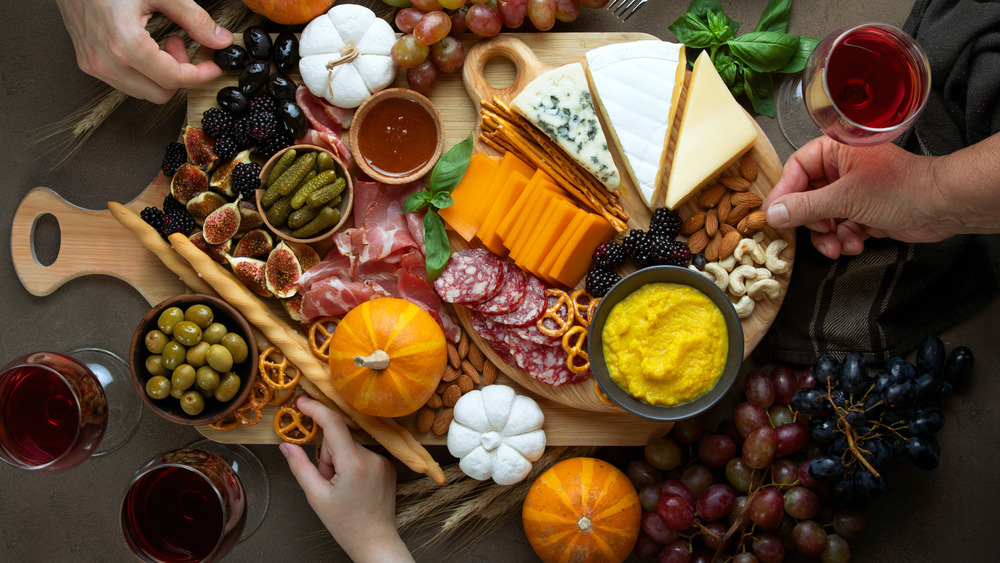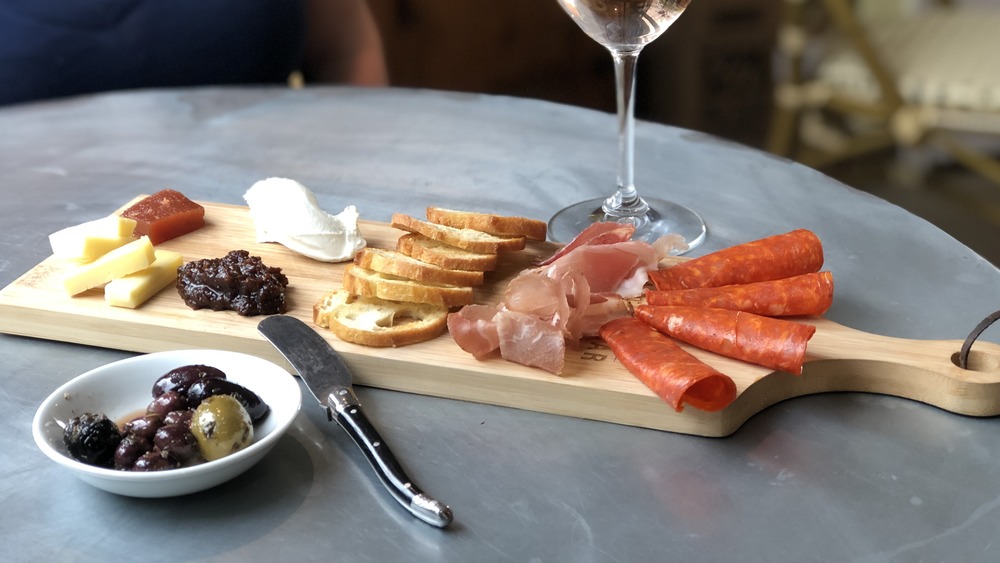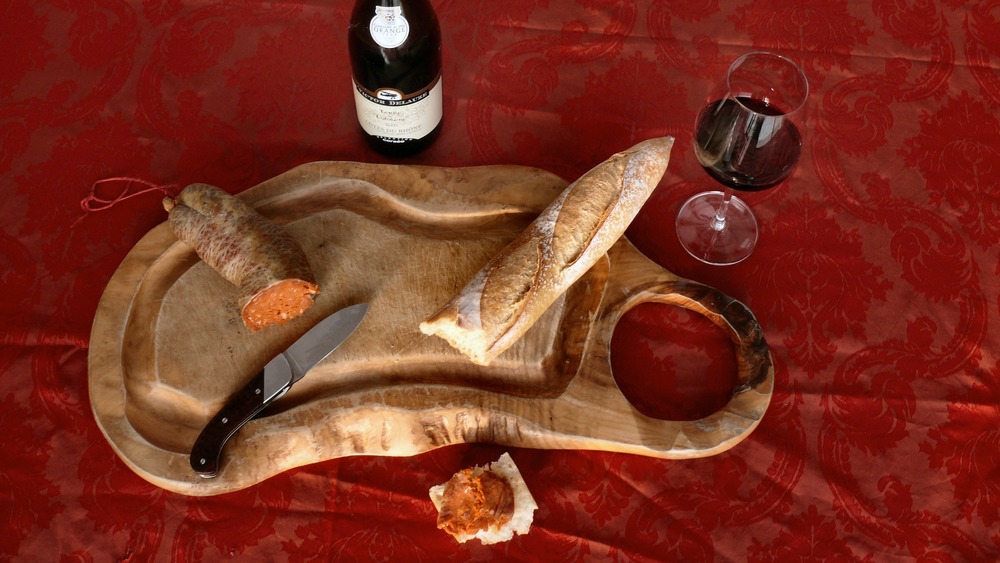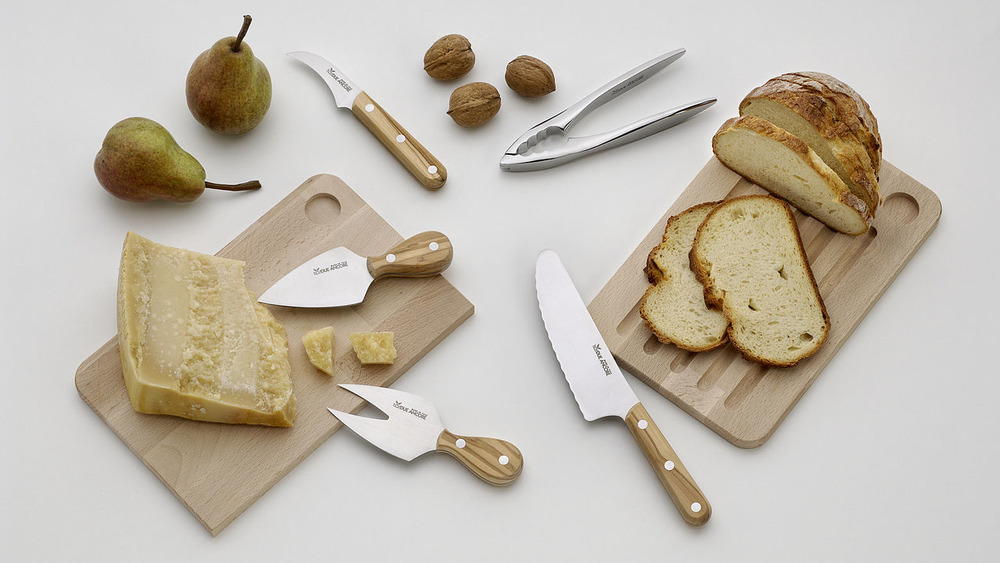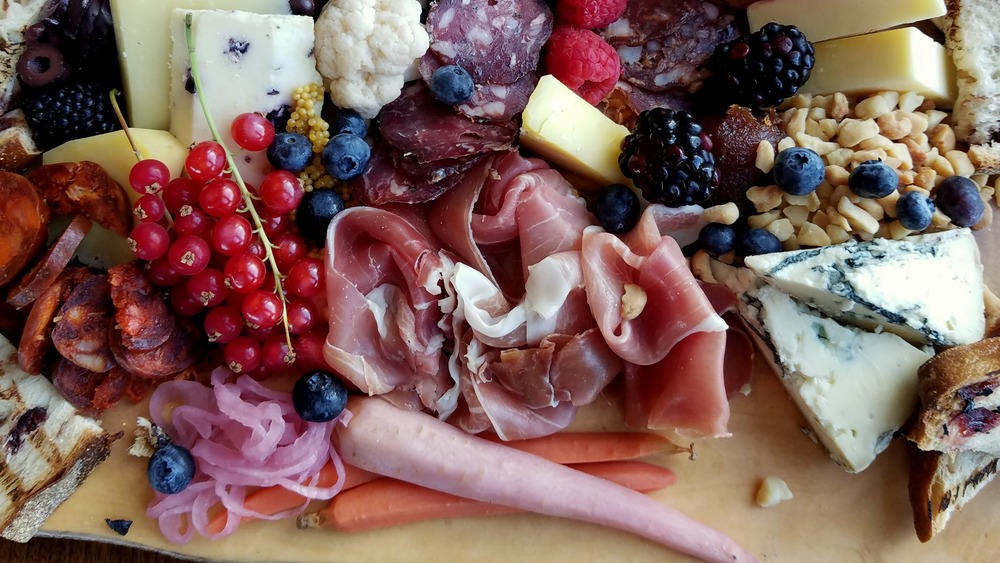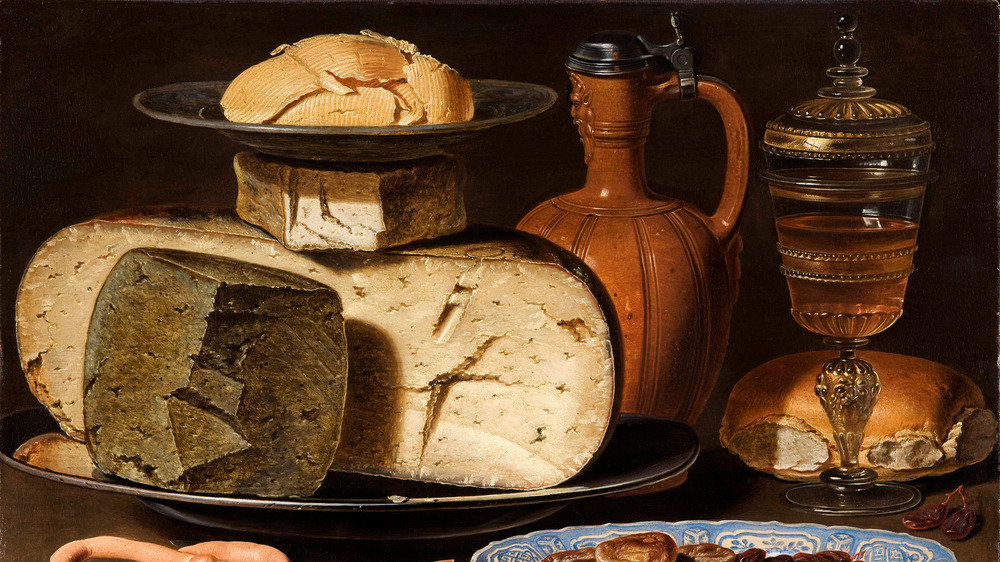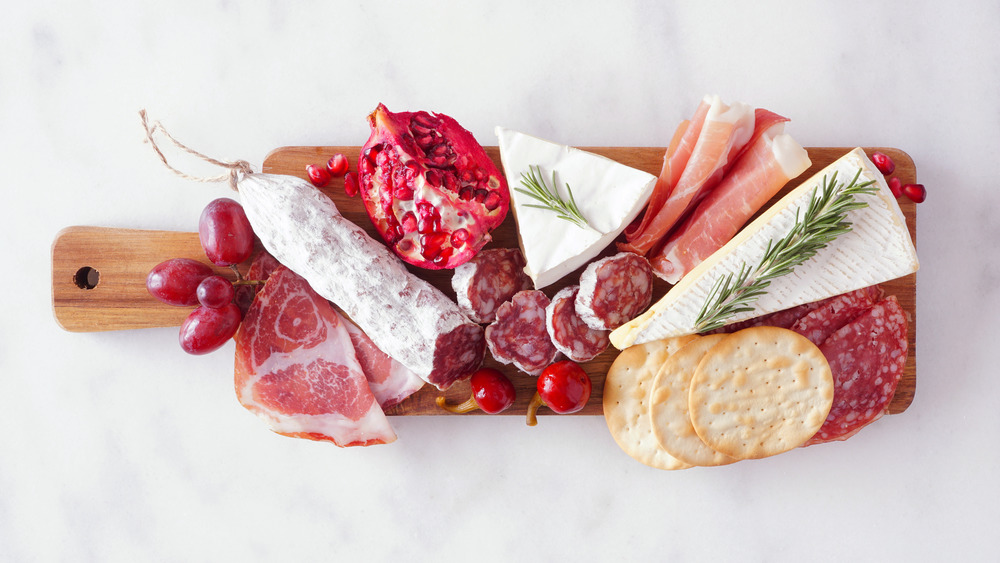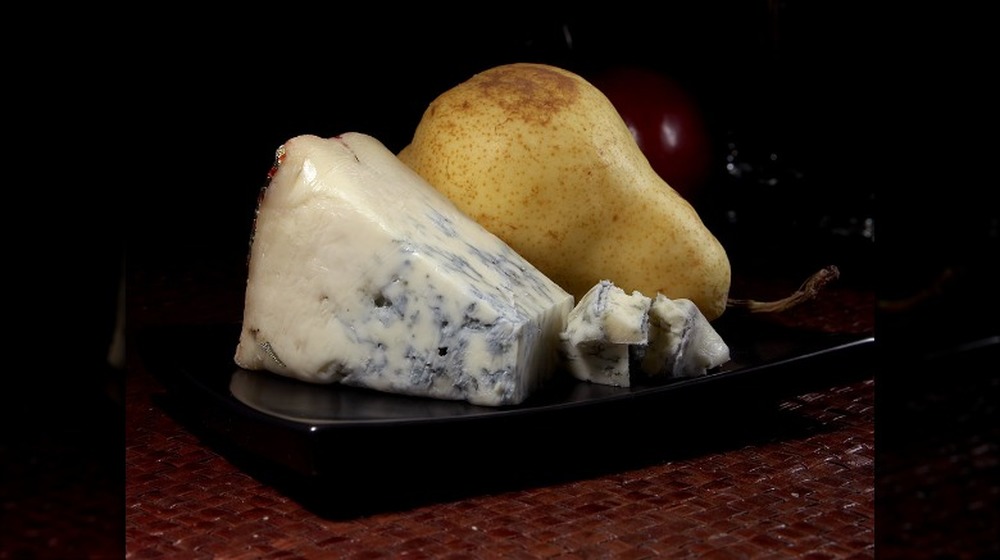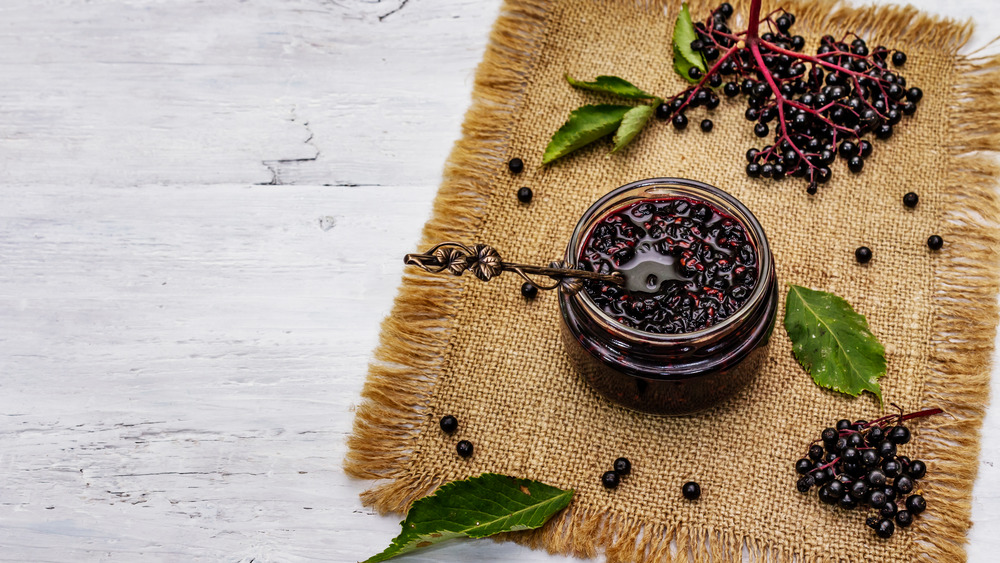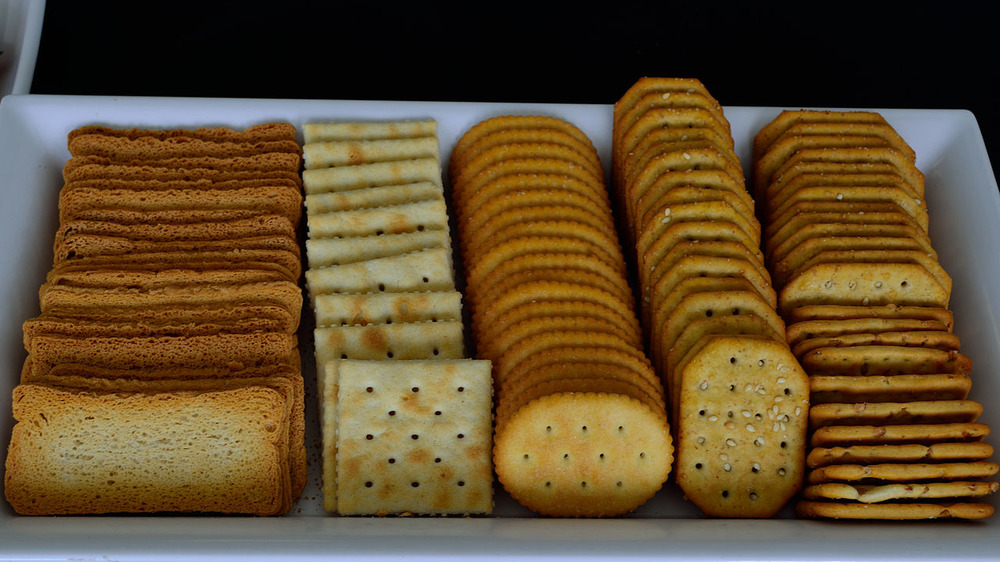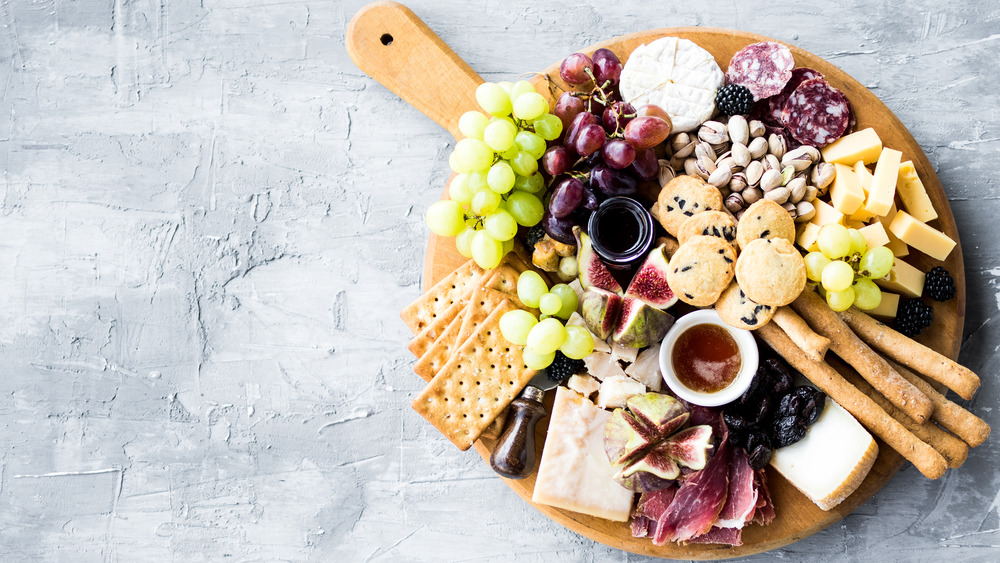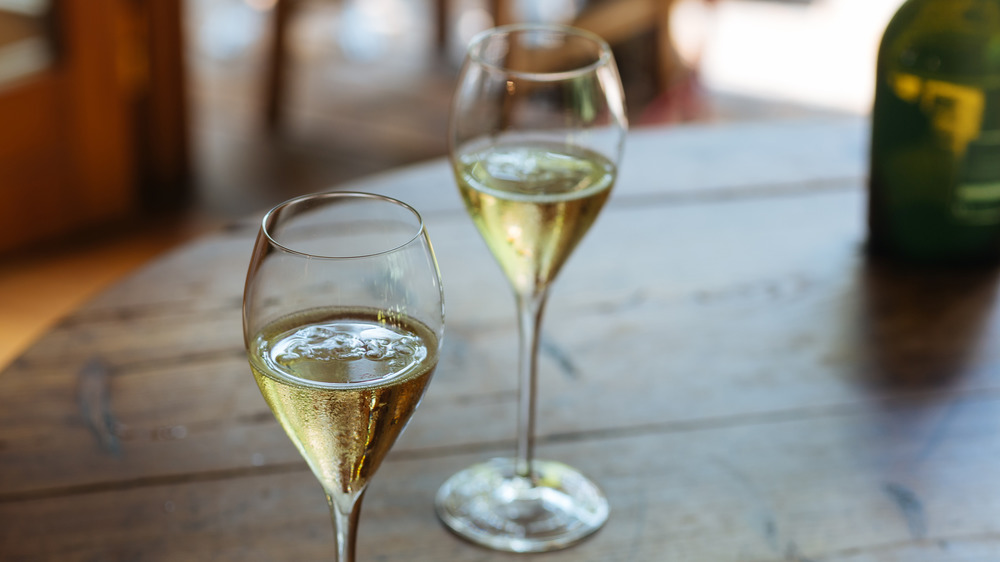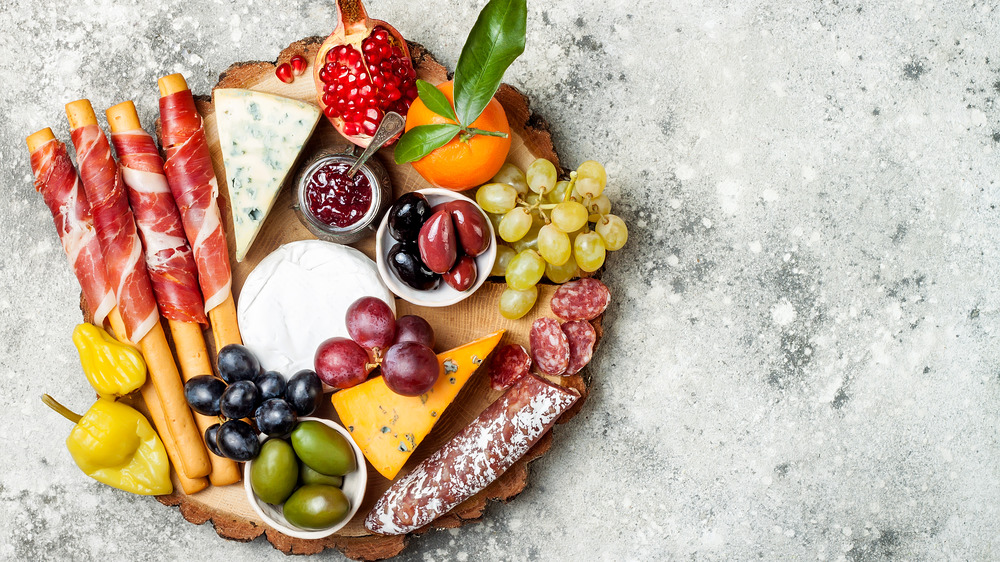How To Build The Perfect Charcuterie Board
When you're hosting a party, few things get foodie guests as excited as a well-planned, brightly colored, and incredibly tasty charcuterie board. Even the pickiest eaters typically find something to love there, amongst the panoply of cheeses, meats, fruits, veggies, nuts, and just about anything else your heart may desire.
According to Garde Manger: The Art and Craft of the Cold Kitchen, charcuterie is a French term, stemming from chair (meat) and cuit (cooked). Makes sense, given how much classic charcuterie boards focus on preserved meat products like bacons, sausages, and pâtés. Don't let that definition hold you back, though, as modern charcuterie draws on a wide palette of food, including cheeses, fresh produce, carb-y crackers, and much more.
Yet, perhaps because of the array of foods bursting forth from charcuterie boards at other events, you may be feeling intimidated. How are you supposed to go from a bare board to the cornucopia you've seen before?
Never fear, because building the ideal charcuterie board isn't so difficult. Even if you're working within a budget, there are ways to create a delicious and visually impressive display that would shine at the center of your next event. Heck, why not assemble one for your household? The everyday could use a nice little surprise on occasion, too.
Keep these basic charcuterie board elements in mind
Part of the beauty of a good charcuterie board is its flexibility. You can mix and match all the delicious bits of food on its surface as much as you want. Arguably, so long as you have some sort of board and some selection of snacks arrayed on top, you could call it a charcuterie board and leave it there.
But if you're interested in the basics or simply want to put out a classic food spread in the more or less original French tradition, then you'd do well to remember the key components of charcuterie. According to Shannon Shipman, there are five elements that form the backbone of this entertaining classic: cheese, something sweet, something savory, meat, and a carbohydrate-heavy base like bread or crackers.
You'll want to include variety in a few of the core elements, like incorporating soft and hard cheeses together on the board. Who doesn't like a little extra cheese, anyway? Sweet foods could be as easy as grapes or as involved as a homemade jam or chutney. The savory accompaniments, apart from the meat, often involve things like olives, nuts, and little pickles often called cornichons. Play within these rules while shopping, and you will already be well on your way to a crowd-pleasing board.
Think about the base board
At this point, chances are good that you're now starting to assemble your shopping list, salivating over each individual ingredient that will make up a truly remarkable and unique charcuterie board. Speaking of which, don't forget the actual surface on which your carefully curated food will rest. You don't need to overthink things, exactly, but neither should you carelessly throw a bunch of cheese cubes on some grimy old cutting board. Having a pretty and sturdy base really will help the overall experience.
Better Homes & Gardens suggests selecting a board made out of sturdy material, like wood or even marble if you have it available. The exact shape and size of your board largely depends on the kind of food you plan to serve. If you include elements that tend to hog space, like leafy greens, you'll naturally want a bigger board. A longer, rectangular base can also make it easier for party goers to cut from big wedges of cheese or a roll of hard salami. Then again, if you're looking to present a lush spread of snacks without totally breaking the bank on gourmet cheeses and meats, a packed and well-dressed but smaller board can make you look good on a budget.
Remember to include serving tools for your charcuterie board
Imagine the glory of your perfect charcuterie board. The base is solid. You've carefully, conscientiously selected the cheeses to appeal to a variety of palates. You picked the perfect cured meats with the right Italian names. You even included some fresh stuff to lighten the load on everyone's hungry and inevitably cheese-laden stomachs. It's all laid out. It looks beautiful. No one can eat it.
That's because you forgot the serving tools. Sure, you could conceivably allow each person to paw at the board's contents, but good hygiene dictates a better solution. Thankfully, getting the right utensils doesn't have to be complicated, though you're more than welcome to break out the vintage silverware if you've got it. On Boards recommends, at minimum, a relatively sharp knife, a fork, and something to spread soft stuff like brie or pâté. Some snacks and condiments, like jams and chutneys, are best served out of small dishes, too. Not to be too obvious, but you'll also want to remember to provide plates, as hands typically make for a poor substitute.
If you care to do so, you can get fancy with dedicated cheese board utensils, but don't fret if you haven't acquired a cheese cleaver at this stage in your life. Pulling the recommended utensils out of your silverware will do just fine, especially for more casual occasions.
Meat makes for a truly tasty charcuterie board
If you happen to be a vegetarian, feel free to skip ahead and plan for the veggie and fruit-laden charcuterie board of your plant-based imaginings. If you are a carnivore, then stay a while longer and pay attention. For many folks, the kinds of meats included in a charcuterie spread can make or break a dish. It certainly will help elevate a board from blah to delicious.
Traditionally speaking, a charcuterie board should include at least a couple of cured meat products. Consider splurging a little on a really nice salami or mortadella to fit this requirement and please everyone's palate. Don't think you have to stick to Italy, however. Food & Wine advocates for a culinary trip across Europe and beyond, with meats like speck, a German take on cured pork shoulder.
Why not make your guests do a little work, too? Give them meat to slice on their own, though you might want to pre-slice a few bits just to make sure everyone gets the message. These could be classics like salami, kielbasa, and capicola, among others. If you're really at a loss, try talking to your local butcher and getting their professional opinion on the best cured meats for your charcuterie board.
Consider the cheeses for your charcuterie board
There is a whole galaxy of cheese out there, figuratively speaking. If you find yourself standing in front of a cheesemonger's station, first count yourself as a lucky person indeed. You have access to a lovely variety of cheeses right before you and a well-informed cheese professional to help you out.
Second, don't freak out. It may look like a lot, but the charcuterie tradition comes with some helpful guidelines to get you started. Even if you don't have an elaborate display of cave-aged, berry-infused, coffee-encrusted cheeses within reach, you can still create an impressive cheese medley for your board. If you're not feeling too shy and have access to a knowledgeable cheesemonger, go ahead and let them know you're seeking charcuterie glory. They should be able to help you find a few good cheeses for practically any budget.
Generally speaking, you want a variety of cheese textures and flavors. Valentina's Corner recommends having a soft cheese on hand, like brie or burrata. You'll also want a hard cheese, such as a high-quality Parmigiano, which rewards you for lightening your wallet with salty, savory flavor. If you care to plant a third cheese on the board, consider a soft, crumbly cheese, like goat cheese. For the funk masters out there, you can't go wrong with a wonderfully stinky bleu cheese or a gorgonzola.
Add something for guests to do themselves with the charcuterie board
Pre-slicing things is a nice gesture, but don't do all of the work yourself. Plenty of classic charcuterie boards require partygoers to do their own work by cutting up ingredients themselves. If anyone balks, you can explain that a little bit of elbow grease will help burn a calorie or two.
These DIY candidates often include meats that are pretty high in salt, meaning that a thin slice will pack plenty of flavor. Hard salami is pretty popular for the slice-it-yourself crowd, especially the Salame di Felino that's so popular amongst some groups that it's sometimes called the "King of Salami." Too rich for your tastes? Then a nice, salt-cured capicola would do just fine, as would a grocery store smoked meat staple like kielbasa sausage.
Guests can also use those handy charcuterie utensils you have so thoughtfully provided to cut bread and cheeses. This means you only have to prep wedges of the stuff, saving you time beforehand. After all, trying to pre-slice soft, gooey brie into individual portions will probably only plunge you into madness.
Remember to include fresh snacks on the charcuterie board
While charcuterie boards are beloved for cured and pickled things, remember to lighten it up. All of that salt, which makes for a real punch of flavor, needs to be balanced to make your charcuterie board shine.
"Fresh" can mean a lot of things. This also depends in large part on your own vision for the board, so feel free to exercise some creativity here. If you want fruit, says Food, good-quality grapes are a standard addition that look pretty appealing too. You may also want to think about berries like blackberries and raspberries, especially if they're in season and at the perfect ripeness. You can also take the option of cutting thin wedges of melon or even dried figs split into halves or quarters. Just be sure to wash and inspect the fruit, then set aside anything that might be bruised or overripe.
For vegetables, think about textures that can bring variety to the overall experience. Raw carrots, sliced into manageable sticks, add crunch and bright color. Same for bell peppers, which come in a variety of colors. Even hearty greens like kale can be sliced up into bite-size portions and give a rich flavor of their own.
Condiments can help to elevate charcuterie boards
Do not dismiss the condiments. Simple as they may seem, these additions can basically bring the level of your charcuterie board up into the stratosphere, if done right. That means we're going to have to go a bit further than your standard grocery store ketchup, but stay on the path, and you'll be well rewarded.
Serious Eats argues that charcuterie boards and cheese plates can have any number of different condiments, but a few options will be sure hits. A good spicy mustard brings heat and a vinegary kick to the table, especially if it's paired with an equally strong cheese like cheddar. Fruit preserves play especially well with softer cheeses, like a sour cherry jam with a creamy, salty brie, perhaps spread on top of a cracker. If you're one of those bold creatures who wants to incorporate a funky bleu cheese, then you could also go a little wild with something dark and sweet to pair with the slightly stinky cheese, like plum preserves.
Now, where are you going to find these condiments? There's no shame in simply buying them, especially if other things have their hold on your time. If you do have a spare hour or so, however, it's not so hard to make your own condiments a day or two before the event, giving the flavors time to meld together.
Get a variety of crackers on the charcuterie board
So, you've got cheeses. You've got meat. You've got salty olives and roasted nuts. You've got bits of fruit and artfully cut vegetables to add a veneer of healthiness. What are you going to put it all on?
It's possible that carbohydrates are one of the most important team members on the entire charcuterie board. Without crackers or slices of tiny bread, how would you convey a soft cheese or piece of salami to your mouth? You could conceivably just pick it up with your hands, but the ethos of a charcuterie board is somewhat more high-minded than shoveling a palm full of roasted almonds into your face.
Therefore, remember the crackers. Striped Spatula reports that there are a wide variety of these starchy elements that don't just convey food to your mouth but also add their own flavor. Simple water crackers are just fine, but don't forget other options like crispy little breadsticks, whole wheat and nutty crackers, and perhaps even a flatbread for a little rustic flair.
Don't be afraid of sweet elements on your charcuterie board
Sweet food items help to balance foods with salt and fat, like cheese and meat. For a nuanced charcuterie board, don't let any one ingredient or flavor dominate. Since snacks like brie or salami aren't usually a hard sell, chances may be good that you need a reminder to include something sweet.
Of course, there are some sweet foods that play well with classic charcuterie boards and some that don't. Unless you're going rogue and trying to build a candy charcuterie (which, to be fair, doesn't sound half bad for an occasion like Halloween), you may want some direction. Shannon Shipman recommends classics like honey, jams, and chutneys. For instance, a salty prosciutto could be even better paired with a sweet, complex honey from a local hive. Fruits like apricots, peaches, and berries can complement the savory elements elsewhere on the board. If you'd rather take a somewhat less processed route, you may simply prefer to serve up whole fruits like grapes or sliced ones like melon.
Hand out drinks to clear the palate
While the general idea of a charcuterie board is to lay out foods that play nicely together, everyone chowing down will likely want to break up the flavor experience a bit. Without a palate cleanser, there's a chance that all of the flavors will start to meld together into one big culinary lump.
To avoid this, serve drinks to help clear away flavors for a new experience every few bites. If people are of legal drinking age, then some alcoholic drinks could definitely be on the menu. Pinot Noir works well as a red wine, while others may appreciate a lighter sparkling wine like Prosecco. For beer, you want to focus on styles that can cut through fatty meats and cheeses, like saisons or porters.
Of course, not everybody can or wants to drink alcohol. Thankfully, there are plenty of non-alcoholic beverages that work here just as well. Fizzy sparkling water is especially useful here, though steer away from overly sweet sodas that will dominate the palate instead of clearing it. If you want to get extra fancy, you can even serve it with a slice of citrus, like lemon, and look like you really have it all together.
Don't forget the visual appeal of charcuterie boards
There is some truth to the old axiom, "you eat with your eyes." Not literally, of course, but there's much to be said for the visual appeal of a dish. With a charcuterie board, there's plenty of opportunity to wow everyone with the look of the food as much as its taste.
Now, generally speaking, you want everything apart from utensils and serving vessels on your board to be edible. Within that restriction, however, you still have a lot of room for creativity. Food recommends using herbs that bring bright colors or new shapes to the arrangement, like full rosemary sprigs, basil leaves, or even lavender, fresh or dried. Also consider how you'll arrange the other foods on the plate. Maybe you want to roll up some of the sliced meat or fill up gaps in the board with nuts. Even a simple move like fanning out crackers and slices of fruit can go a long way.
If you're interested in taking an extra step, you could really wow everybody with some edible flowers. The Royal Horticultural Society lists off colorful and consumable blooms like elderflowers, hibiscus, marigold, and more. That said, be sure you know what kind of flowers you're collecting, trim off inedible bits like the stamen, and remember to wash everything thoroughly before it meets the board.
